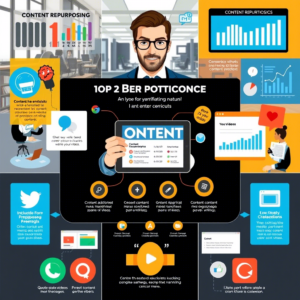In a world where attention spans are shrinking and digital noise is louder than ever, finding fresh ways to connect with your audience can feel like shouting into the void. But what if you could reach people while they’re commuting, working out, or even doing the dishes? That’s where podcasts come in.
Podcasts have exploded in popularity over the past decade, offering a unique opportunity for creators and businesses to share their message in an intimate, accessible format. Whether you’re a marketer, entrepreneur, blogger, or content creator, leveraging podcasts can significantly extend your reach and deepen your connection with your audience.
In this article, we’ll explore how you can use podcasts as a powerful tool to amplify your content, engage new audiences, and build a loyal community. From repurposing existing material to creating original episodes and promoting your show effectively, you’ll discover practical strategies that can work for any niche or brand.
By the end of this guide, you’ll not only understand why podcasts matter but also be equipped with actionable steps to start using them today. Let’s dive in and unlock the full potential of podcasting.
1. Why Podcasts Are a Game-Changer for Content Creators
Before jumping into strategy, it’s important to understand why podcasts have become such a compelling medium for content extension.
First, consider the numbers: according to Edison Research, over 60% of Americans over the age of 12 have listened to a podcast , and more than a quarter of them listen weekly. That’s millions of potential listeners tuning in during moments when other forms of content—like blogs or videos—are impractical.
Unlike written content, podcasts allow people to consume information hands-free and eyes-free. This makes them ideal for multitasking, whether someone is driving, cooking, or walking the dog. It’s a medium that fits seamlessly into modern life.
Moreover, podcasts offer a level of intimacy that’s hard to replicate elsewhere. Hearing someone’s voice builds trust and familiarity. Regular listeners often feel like they know the host personally, which can translate into stronger brand loyalty and engagement.
So, if you’re already creating content—whether it’s blog posts, social media updates, or videos—podcasting gives you a new channel to share those ideas in a format that many people prefer.
And here’s the best part: you don’t need a massive budget or technical expertise to get started. With a simple microphone, recording software, and a hosting platform, you can begin reaching new audiences right away.
2. Repurpose Existing Content into Engaging Podcast Episodes
One of the most effective—and time-efficient—ways to start using podcasts is by repurposing your existing content.
Think about all the blog posts, YouTube videos, newsletters, or social media threads you’ve created. These pieces already resonate with your audience and contain valuable insights. By transforming them into podcast episodes, you’re giving your content a second life—and reaching people who might never have seen it before.
For example, if you’ve written a detailed blog post on productivity hacks, you could turn it into a 20-minute episode where you discuss each tip in a conversational tone. Or if you’ve done an interview on video, extract the audio and upload it as a podcast episode.
This approach not only saves you time but also helps reinforce your key messages across different formats. Listeners may later seek out your blog post or video after hearing the audio version, increasing overall engagement with your content.
To make this process easier:
- Use transcription tools to convert audio interviews into blog posts.
- Pull quotes from long-form content to create teaser clips for social media.
- Create mini-series around popular topics to keep listeners coming back.
The goal is to maximize the value of every piece of content you produce. By thinking strategically about how your existing material can be adapted for podcasting, you’ll stretch your creative efforts further and reach a broader audience.
3. Create Original Podcast Content to Attract New Audiences
While repurposing content is a great starting point, developing original podcast episodes can help you attract entirely new listeners who aren’t yet familiar with your brand.
Original content allows you to explore fresh angles, introduce new guests, or dive deeper into niche topics that haven’t been covered elsewhere. Think of it as expanding your content universe rather than just redistributing what’s already there.
Here are a few formats to consider:
- Solo shows : Share your thoughts, experiences, or lessons learned on a specific topic.
- Interview-style podcasts : Invite industry experts, influencers, or customers to share their insights.
- Roundtable discussions : Bring together multiple voices to debate or explore trending issues.
- Storytelling or narrative series : Present your content in a compelling, story-driven format.
Each of these formats has its own strengths. Solo shows are great for building personal authority and consistency, while interviews bring in fresh perspectives and expand your network. Roundtables foster dynamic conversations, and storytelling engages listeners emotionally.
When planning your episodes, think about what kind of content would add value to your target audience. What problems do they face? What questions do they ask? What keeps them up at night?
Answering these questions will help you craft relevant, engaging content that resonates with listeners and encourages them to return week after week.
Remember, consistency is key. A well-planned editorial calendar will help you stay organized and ensure a steady flow of content that keeps your audience engaged.
4. Promote Your Podcast Across Multiple Platforms
Creating great content is only half the battle. To truly extend your reach, you need to promote your podcast effectively across multiple platforms.
Start by listing your podcast on major directories like Apple Podcasts, Spotify, Google Podcasts, and Stitcher. These platforms serve as discovery hubs and can significantly boost your visibility.
Next, leverage your existing marketing channels:
- Social Media : Share short clips, behind-the-scenes footage, or key takeaways from your episodes. Tools like Headliner or Descript make it easy to create engaging audio snippets for Instagram Reels, TikTok, or YouTube Shorts.
- Email Marketing : Include links to new episodes in your newsletter. You can even create a dedicated email series featuring highlights from your podcast.
- Website Integration : Embed podcast players directly into your website or blog. This makes it easy for visitors to listen without leaving your site.
- Cross-Promotion : Collaborate with other podcasters in your niche. Appear as a guest on another show, or invite others onto yours. This exposes your podcast to new audiences and builds relationships within your community.
You should also encourage listeners to subscribe, rate, and review your podcast. Positive reviews improve your rankings in podcast directories and signal to potential listeners that your show is worth their time.
Another smart tactic is to create show notes for each episode. These summaries include timestamps, key points, resources mentioned, and links to related content. Not only do they enhance listener experience, but they also improve SEO since search engines can index the text.
By taking a multi-channel promotional approach, you’ll increase your chances of being discovered by new listeners who align with your target audience.
5. Measure Success and Optimize Your Strategy
Just like any content marketing effort, podcasting requires ongoing evaluation and refinement. Without tracking performance, it’s impossible to know what’s working and what needs improvement.
Most podcast hosting platforms provide analytics that show how many downloads each episode receives, where your listeners are located, and which platforms they use. Pay attention to trends—do certain topics perform better? Do interviews generate more listens than solo episodes?
Use this data to refine your content strategy. For instance, if episodes on productivity tips consistently receive high engagement, consider creating a mini-series focused on that theme.
Also, look beyond downloads. Monitor social shares, website traffic from podcast referrals, and conversions (such as newsletter signups or sales) linked to your podcast. These metrics give a fuller picture of how your podcast contributes to your overall marketing goals.
Engage with your audience by asking for feedback. Encourage listeners to leave reviews, send in questions, or participate in polls. The more you involve them, the more invested they’ll become in your content.
Finally, stay open to evolving your format or topics based on what your audience wants. Flexibility is key in maintaining relevance and growing your podcast over time.
Remember, success doesn’t happen overnight. It takes time to build an audience and establish your voice in the podcasting space. But with consistent effort, thoughtful strategy, and a willingness to adapt, your podcast can become one of your most powerful content tools.
Conclusion
Podcasts offer a unique and powerful way to extend your content reach, connect with your audience on a deeper level, and grow your brand in today’s fast-paced digital landscape.
Whether you choose to repurpose existing material, create original episodes, or combine both approaches, the opportunities are vast. From solo shows to expert interviews, storytelling formats to roundtable discussions, podcasting gives you the flexibility to experiment and find what resonates most with your audience.
Promoting your podcast effectively across multiple platforms ensures your content reaches new ears, while tracking performance allows you to fine-tune your strategy for maximum impact.
As we’ve explored throughout this guide, the benefits of podcasting go far beyond simply adding another channel to your content mix. It’s about building trust, establishing authority, and providing real value to your listeners—wherever and whenever they choose to consume content.
If you haven’t already, now is the perfect time to explore podcasting. Start small, stay consistent, and focus on delivering meaningful content that speaks directly to your audience’s needs and interests.
Are you ready to hit record?
Let us know in the comments below—or better yet, share your favorite podcasting tip! We’d love to hear how you’re using podcasts to grow your reach.




